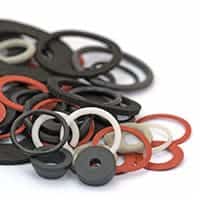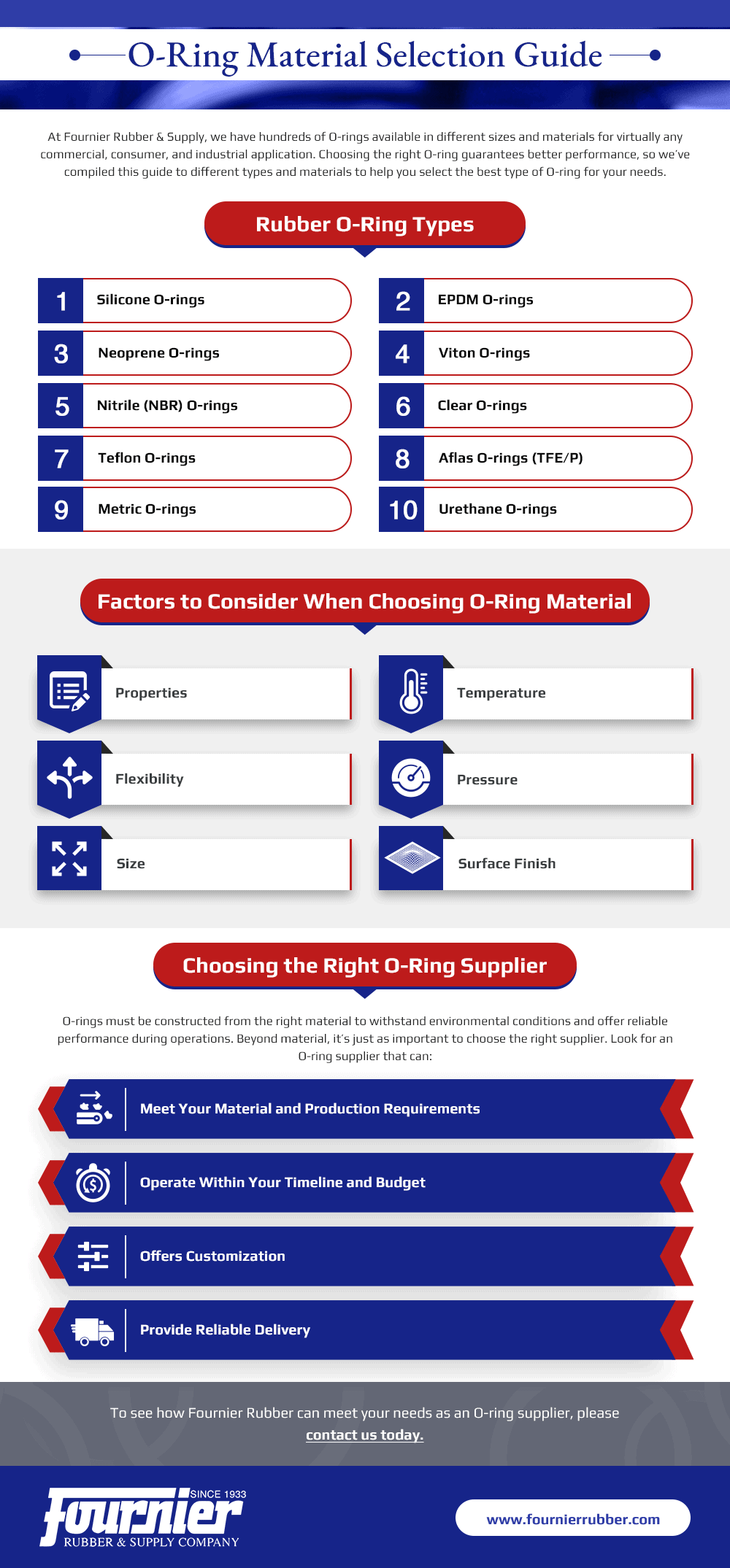At Fournier Rubber & Supply, we have hundreds of O-rings available in different sizes and materials for virtually any commercial, consumer, and industrial application. Choosing the right O-ring guarantees better performance, so we’ve compiled this guide to different types and materials to help you select the best type of O-ring for your needs.
Rubber O-Ring Types
Rubber materials are cost-effective and hold their shape well, making them ideal for use in sealing applications. Some of the most popular rubber material options we have in our O-ring inventory include:
- Silicone O-rings. Silicone resists fatigue, flex damage, and damage from high temperatures. It can also withstand ozone and UV radiation for outdoor applications. These O-rings provide insulation, flexibility, and reliable sealing capabilities in static use cases.
- EPDM O-rings. Ethylene propylene diene monomer (EPDM) rubber is a cost-effective synthetic material that resists damage from mild chemicals, acids, and steam. These O-rings are commonly used in water systems, automobiles, and manufacturing and production systems for food, dairy, and pharmaceutical products.
- Neoprene O-rings (chloroprene). Neoprene is an excellent material for outdoor O-ring applications where the component will face exposure to the elements. Neoprene O-rings resist damage from weather, water, oxidation, and UV radiation. They also withstand exposure to coolants and ammonia, making them a popular choice for refrigerator assemblies.
- Viton O-rings (fluorocarbon elastomer). Viton is a relatively hard rubber that retains its characteristics in temperatures from -20°F to 400°F. It features excellent resistances to chemicals, fire, weather, and oils. It also resists physical damage, providing long-term performance in rough conditions.
- Nitrile (NBR) O-rings. Nitriles—especially high-concentration nitriles—resist oils and fuels, so they won’t break down in the presence of these and other petroleum products. This makes them an excellent choice for use in fuel systems and machinery. The material also complies with many military material standards. Of note, nitrile O-rings can become inflexible at low temperatures.
- Clear O-rings. These thin, flat O-rings are transparent, making them an ideal choice for highly visible applications or sensitive assemblies that need high standards of cleanliness. Clear O-rings are chemically inert, non-toxic, and odorless, so they won’t interfere with the production of consumable goods. Most clear O-rings are made from silicone compounds.
- Teflon O-rings. Polytetrafluoroethylene (PTFE)—commonly known by the brand name Teflon—is a synthetic alternative to elastomers that resists corrosion, works well in electrical environments, and retains its positive characteristics across a wide temperature range. PTFE O-rings also have an extremely long lifespan.
- Teflon-encapsulated O-rings. Teflon encapsulation gives these O-rings an excellent level of chemical resistance. Because these O-rings have a rubber core, they retain flexibility and resistance to high temperatures.
- Aflas O-rings (TFE/P). Aflas O-rings offer resistances to steam, water, other chemicals, high temperatures, and caustic environments. This makes them ideal for use in processing assemblies that handle the production of liquid goods, such as oil.
- Metric O-rings. For equipment and assemblies measured in metric units, these O-rings are measured in millimeters for easy sourcing and ordering of O-rings that fall outside of normal AS568 sizes.
- Urethane O-rings. Polyurethane rubbers include polyester urethane (AU) and polyether urethane (EU), both of which are strong and wear-resistant. Polyester urethane O-rings can resist oils and solvents, though they may weaken when exposed to water. Polyether urethane O-rings can resist low-level fuels and oils while also resisting hydrolysis.
Fournier Rubber & Supply also provides custom O-rings constructed from vulcanized rubber upon request.
Factors to Consider When Choosing O-Ring Material
As you select materials, keep these important factors in mind:
- Properties. The type of material you choose may have a long or short lifespan, may require different production techniques, and can cost more or less than comparable materials.
- Temperature. Consider the operating temperature your O-ring needs to function within. Nitrile-based O-rings are popular for high-temperature applications, whereas different silicones can resist wider temperature ranges.
- Flexibility. The inner diameter of your O-ring must be smaller than the installation groove in its mating component, and it must stretch to fill that groove. This characteristic helps ensure a reliable seal.
- Pressure. Consider the hardness of the material. A higher application pressure for the O-ring will require higher shore hardness.
- Size. Choose the appropriate size based on the size of the mating surface’s groove—both diameter and the groove’s width—and the flexibility of the material.
- Surface finish. O-rings should fall within a tight surface roughness range of 5-16 µ inch RMS to minimize the risk of friction or accelerated wear.
Choosing the Right O-Ring Supplier
O-rings must be constructed from the right material to withstand environmental conditions and offer reliable performance during operations. Beyond material, it’s just as important to choose the right supplier. Look for an O-ring supplier that can:
- Meet your material and production requirements
- Operate within your timeline and budget
- Offers customization
- Provide reliable delivery
To see how Fournier Rubber can meet your needs as an O-ring supplier, please contact us today.






